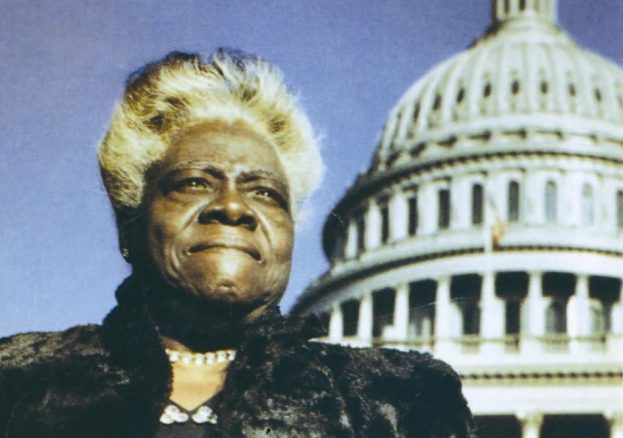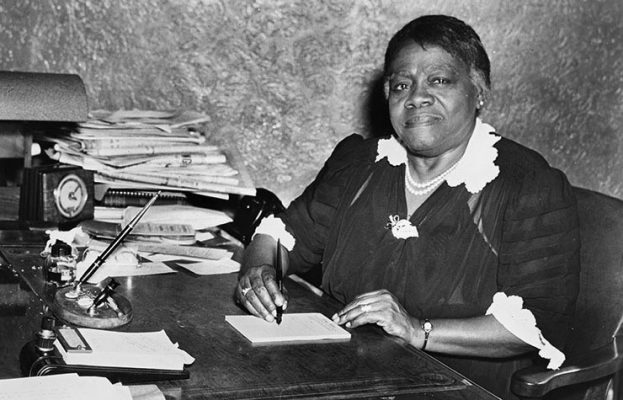
Born Mary Jane McLeod on July 10, 1875 in Mayesville, South Carolina to two slave parents, Mary began working in the fields at the age of five with the rest of her family. However, Mary took an interest in becoming educated and hoped to become an African missionary, and with financial benefactors, Mary attended college in an attempt at realising this dream.
However, whilst Bethune was studying, it emerged that Black missionaries were not needed, and she moved her aspirations towards teaching.
Career
National Association of Colored Women
In 1896, the National Association of Colored Women was formed to promote the needs of Black Women. Bethune served as the Florida chapter president of the NACW from 1917 to 1925 and worked to register Black voters, which was resisted by White society who had made it almost impossible by a variety of obstacles in Florida law.
Bethune also served as the president of the Southeastern Federation of Colored Women’s Clubs from 1920 to 1925, which worked to improve opportunities for black women, with members of the resurgent Ku Klux Klan threatening her for her work.
She was elected as national president of the NACW in 1924. While the organisation struggled to raise funds for regular operations, Bethune envisioned its acquiring a headquarters and hiring a professional executive secretary; she implemented this when NACW bought a property at 1318 Vermont Avenue in Washington, DC. She led it to be the first black-controlled organisation with headquarters in the capital.
Gaining a national reputation, in 1928 Bethune was invited to attend the Child Welfare Conference called by Republican President Calvin Coolidge. In 1930 President Herbert Hoover appointed her to the White House Conference on Child Health.
Southeastern Association of Colored Women’s Clubs
The Southeastern Federation of Colored Women’s Clubs (eventually renamed as the Southeastern Association of Colored Women’s Clubs) elected Bethune as president after its first conference in 1920 at the Tuskegee Institute. They intended to reach out to Southern, White Women for support and unity in gaining rights for black women.
Meeting in Memphis, Tennessee, all of the women agreed about what needed to be changed, until they came to the topic of suffrage. The white women at the conference tried to strike down a resolution on Black suffrage. The SACWC responded by issuing a pamphlet entitled Southern Negro Women and Race Co-Operation; it delineated their demands regarding conditions in domestic service, child welfare, conditions of travel, education, lynching, the public press, and voting rights. The group went on to help register Black Women to vote after they were granted suffrage.
National Council of Negro Women
In 1935 Bethune founded the National Council of Negro Women in New York City, bringing together representatives of 28 different organisations to work to improve the lives of black women and their communities. Bethune said of the council:
“It is our pledge to make a lasting contribution to all that is finest and best in America, to cherish and enrich her heritage of freedom and progress by working for the integration of all her people regardless of race, creed, or national origin, into her spiritual, social, cultural, civic, and economic life, and thus aid her to achieve the glorious destiny of a true and unfettered democracy.”
In 1938, the NCNW hosted the White House Conference on Negro Women and Children, demonstrating the importance of black women in democratic roles. During World War II, the NCNW gained approval for black women to be commissioned as officers in the Women’s Army Corps. Bethune also served as a political appointee and the Special Assistant to the Secretary of War during the war.
National Youth Administration
The National Youth Administration (NYA) was a federal agency created under Roosevelt’s Works Progress Administration (WPA). It provided programs specifically to promote relief and employment for young people. It focused on unemployed citizens aged sixteen to twenty-five years who were not in school. Bethune lobbied the organisation so aggressively and effectively for minority involvement that she earned a full-time staff position in 1936 as an assistant.
Within two years, Bethune was appointed to position of Director of the Division of Negro Affairs, and as such, became the first African-American female division head. She managed NYA funds to help black students through school-based programs. She was the only black agent of the NYA who was a financial manager. She ensured black colleges participation in the Civilian Pilot Training Program, which graduated some of the first black pilots.
Within the administration, Bethune advocated for the appointment of Black NYA officials to positions of political power. Bethune’s administrative assistants served as liaisons between the National Division of Negro Affairs and the NYA agencies on the state and local levels. The high number of administrative assistants composed a work force commanded by Bethune. They helped gain better job and salary opportunities for Black people across the country. During her tenure, Bethune also pushed federal officials to approve a program of consumer education for Black people, and a foundation for disabled Black children and she planned for studies for Black workers’ education councils. National officials did not support these due to inadequate funding and fear of duplicating the work of private non-governmental agencies. The NYA was terminated in 1943.

Black Cabinet
Bethune became a close and loyal friend of Eleanor & Franklin Roosevelt. At the Southern Conference on Human Welfare in 1938, held in Birmingham, Alabama, Eleanor Roosevelt requested a seat next to Bethune despite state segregation laws. Roosevelt frequently referred to Bethune as “her closest friend in her age group.” Bethune told Black voters about the work being done on their behalf by the Roosevelt Administration, and made their concerns known to the Roosevelts. She had unprecedented access to the White House through her relationship with the First Lady.
She used her access to form a coalition of leaders from black organisations called the Federal Council of Negro Affairs, but which came to be known as the Black Cabinet. It served as an advisory board to the Roosevelt administration on issues facing black people in America. It was comprised of numerous talented Black citizens who had been appointed to positions in federal agencies. This was the first collective of Black people working in higher positions in government.
Civil Rights
In 1931 the Methodist Church supported merging of the Daytona Normal and Industrial School and the Cookman College for Men into Bethune-Cookman College, established first as a junior college. Bethune became a member of the church but it was segregated in the South, making Bethune prominent in the primarily Black Florida Conference.
While she worked to integrate the mostly White Methodist Episcopal Church, South, she protested its initial plans for integration because they proposed separate jurisdictions based on race.
On Sundays she opened her school to tourists in Daytona Beach, showing off her students’ accomplishments, hosting national speakers on Black issues, and taking donations. She ensured that these Community Meetings were integrated. A Black teenager in Daytona at the turn of the 20th century later recalled: “Many tourists attended, sitting wherever there were empty seats. There was no special section for white people.”
Bethune organised the first officer candidate schools for Black women. She lobbied federal officials, including Roosevelt, on behalf of African-American women who wanted to join the military.
Death
On May 18, 1955, Bethune died of a heart attack, with her death being followed by editorial tributes in African-American newspapers across the United States. Upon her death, columnist Louis E. Martin said, “She gave out faith and hope as if they were pills and she some sort of doctor.”
The mainstream press praised her as well. Christian Century suggested, “the story of her life should be taught to every school child for generations to come.” whilst The New York Times noted she was, “one of the most potent factors in the growth of interracial goodwill in America.”
